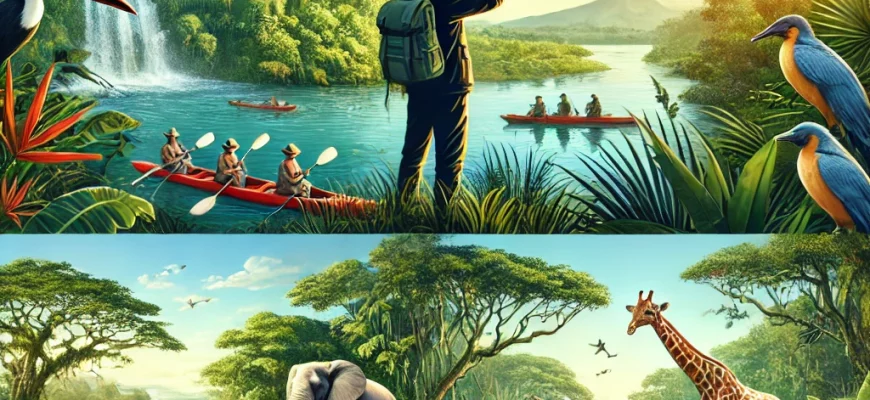Sustainable travel, emphasizing environmental conservation and local community well-being, has gained traction among those who cherish nature and wildlife. This method of exploration enables tourists to delve into untouched natural spaces, observe remarkable wildlife, and support the ongoing protection of these vital habitats. We will delve into the premier global destinations for eco-tourism that present unforgettable and meaningful experiences for those passionate about nature and wildlife.
1. Costa Rica
Overview
Widely recognized as the cradle of eco-tourism, Costa Rica boasts incredible biodiversity and a deep-rooted dedication to eco-consciousness. This compact nation is dotted with green lodgings, numerous parks, and protective reserves.
Highlights
- The Monteverde Cloud Forest Reserve: A treasure trove of over 2,500 plant varieties, numerous mammals, and an impressive array of birds.
- Tortuguero National Park: Often compared to the Amazon, this area is essential for the survival of the endangered green sea turtle.
- Arenal Volcano: Encircling this active volcano are hot springs, cascades, and vibrant rainforests.
2. Galápagos Islands, Ecuador
Overview
Declared a UNESCO World Heritage locale, the Galápagos Islands stand out as a premier destination for witnessing extraordinary wildlife, thanks to their isolation which has led to the evolution of species exclusive to these islands.
Highlights
- Encounter the iconic Galápagos giant tortoises in the wild.
- Dive into the marine-rich waters, home to iguanas, playful sea lions, and a kaleidoscope of fish.
- Enjoy birdwatching opportunities, spotting creatures such as the blue-footed booby and the Galápagos penguin.
3. Kenya
Overview
Kenya is a byword for safari adventures, with unparalleled opportunities for wildlife observation. The nation’s sprawling grasslands, rugged scenery, and conservation efforts render it an eco-tourism leader.
Highlights
- The Maasai Mara National Reserve, scene of the Great Migration.
- Amboseli National Park, renowned for its elephant groups and the backdrop of Mount Kilimanjaro.
- Laikipia Plateau, a model of conservation with its luxurious eco-lodges and teeming wildlife.
4. Borneo, Malaysia, and Indonesia
Overview
The world’s third-largest island, Borneo, is a wildlife enthusiast’s dream, featuring ancient forests and a rich variety of life. The island’s eco-tourism highlights span across territories of Malaysia, Indonesia, and Brunei.
Highlights
- Orangutan conservation projects offer insights into efforts to reintroduce these apes into their natural habitat.
- The Kinabatangan River invites wildlife spotting of rare creatures like pygmy elephants and proboscis monkeys.
- Ascend Southeast Asia’s tallest peak, Mount Kinabalu, and explore its namesake national park.
5. Norway
Overview
Norway’s breathtaking vistas, encompassing fjords, peaks, auroras, and wildlife-rich parks, align with its environmental stewardship, making it an eco-tourism gem.
Highlights
- The Arctic haven of Svalbard allows for encounters with polar bears and other Arctic species.
- The majestic Geirangerfjord, a World Heritage site known for its dramatic landscapes.
- Jotunheimen National Park, a hiker’s paradise with a chance to see reindeer and other creatures.
6. Botswana
Overview
Botswana prioritizes ecologically sensitive, high-quality tourism to safeguard its wild regions and their inhabitants. It’s home to some of the most unspoiled and isolated safari zones in Africa.
Highlights
- The Okavango Delta, a UNESCO site supporting diverse fauna.
- Chobe National Park, with its numerous elephants and river safaris.
- The Kalahari Desert, where visitors can explore its unique environment and connect with the indigenous San community.
7. New Zealand
Overview
With varied terrains ranging from snowy mountains to lush rainforests, New Zealand ranks highly for eco-tourism. The nation’s commitment to sustainability provides a spectrum of eco-friendly activities.
Highlights
- Fiordland National Park and the renowned Milford Sound, with its stunning vistas and wildlife.
- Abel Tasman National Park, celebrated for its pristine shores and native species.
- Kaikoura, a prime spot for whale encounters and dolphin swims.
8. Madagascar
Overview
An island of distinct biodiversity, where a vast majority of its wildlife is endemic. Madagascar’s conservation initiatives render it a top eco-tourism spot.
Highlights
- The Avenue of the Baobabs, lined with these ancient trees.
- Andasibe-Mantadia National Park, a sanctuary for the Indri lemur and other endemic species.
- The Tsingy de Bemaraha, a World Heritage site recognized for its striking geological formations.
9. Patagonia, Argentina, and Chile
Overview
Straddling Argentina and Chile, Patagonia’s awe-inspiring landscapes offer nature aficionados a haven of unparalleled beauty.
Highlights
- Torres del Paine National Park, known for its soaring peaks and diverse fauna.
- Los Glaciares National Park, the abode of the grand Perito Moreno Glacier.
- The Fitz Roy Range, presenting premier trails and climbing pursuits in the South American region.
10. Iceland
Overview
The stark and magnificent scenery of Iceland, encompassing everything from spouting geysers and cascading falls to icy glaciers and the aftermath of volcanic eruptions, positions it as a prime spot for nature-based tourism. Iceland’s dedication to using sustainable energy sources and safeguarding the environment adds to its attractiveness for visitors.
Highlights
- Golden Circle: This famed tourist circuit features the historical Thingvellir National Park, the Geysir hot spring zone, and the majestic Gullfoss waterfall.
- Vatnajökull National Park: This park is the site of the largest ice cap in Europe and showcases a variety of extraordinary geological formations.
- Westfjords: Known for its untouched wilderness, this secluded area boasts a wealth of bird species and naturally occurring warm springs.
Conclusion
Nature-focused travel provides an avenue to immerse oneself in some of the planet’s most breathtaking landscapes while supporting conservation efforts. Whether one is navigating the dense rainforests of Borneo, observing the diverse fauna of Kenya’s grasslands, or venturing through the vast fjords of Norway, these locales offer indelible experiences for aficionados of the natural world. Opting for eco-tourism not only allows travelers to revel in the splendor of Earth in a mindful manner but also plays a part in preserving these awe-inspiring sites for posterity to discover and treasure.





